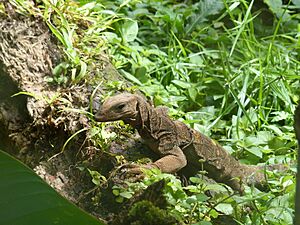Solomon Island spiny monitor facts for kids
Quick facts for kids Solomon Island spiny monitor |
|
|---|---|
 |
|
| Conservation status | |
| Scientific classification | |
| Genus: |
Varanus
|
| Species: |
spinulosus
|
| Synonyms | |
|
Varanus indicus spinulosus Mertens, 1941 |
|
The Varanus spinulosus, also known as the Solomon Island spiny monitor, Isabel monitor, or spiny-neck monitor, is a type of monitor lizard. It lives only in the Solomon Islands archipelago. You can find it on Santa Isabel Island, San Jorge Island in the Solomon Islands, and Bourgainville Island in Papua New Guinea.
Contents
Discovering the Spiny Monitor
How Scientists Named This Lizard
The spiny monitor was first described by a scientist named Robert Mertens in 1941. He studied a single male lizard and first thought it was a type of mangrove monitor. He called it Varanus indicus spinulosus.
For a long time, this lizard was only known from that one original specimen. Then, in 1989, five more female lizards were found. In 1994, scientists decided it was different enough to be its own species, so they named it Varanus spinulosus.
Later, in 2016, scientists gave this lizard its own special group called Solomonsaurus. This name was chosen because of its unique scales. The word spinulosus means "spiny," which perfectly describes its skin!
What Does the Spiny Monitor Look Like?
Unique Features of the Spiny Monitor
This monitor lizard looks a bit like mangrove monitors, but it has some very special features. Its skin is spiny because each small body scale is strong and shaped like a cone. This spiny texture is unique among all monitor lizards!
The spiny monitor has 3 to 4 rows of bright yellow spots on its back. It also has fairly large eyes. A special sharp ridge, called a canthus, runs from its snout to its eye. This feature is not common in other monitor species.
Most spiny-necked monitors are very dark in color. Unlike many mangrove monitors, this species has a solid black belly. It also lacks the light markings often seen on the faces of other monitor lizards. Their tongues can even be a pink color!
Where Do Spiny Monitors Live?
Finding the Right Home
Spiny monitors usually live in areas that are dry for part of the year, but also get a lot of rain at other times. These special environments are found in the Bismarck Archipelago and the Solomon Island chains.
How Long Do Spiny Monitors Live?
Lifespan of the Spiny Monitor
In places like zoos or private collections, spiny-necked monitors typically live for about 7.5 years.
What Do Spiny Monitors Eat?
The Spiny Monitor's Diet
Like most other monitor lizards, the spiny monitor is a carnivore, meaning it eats meat. They enjoy eating insects, other small creatures without backbones, and birds.
They have also been seen eating eggs from large ground-nesting birds called megapodes, and even fish. They often come out of the bushes to find food. When the tide is low, they might search for dead fish in the areas between the land and the sea.
Spiny Monitors and People
Monitors as Pets
In the 1990s, many V. spinulosus lizards were brought into other countries. They were often called "mangrove monitors" because people wanted them more as pets.


